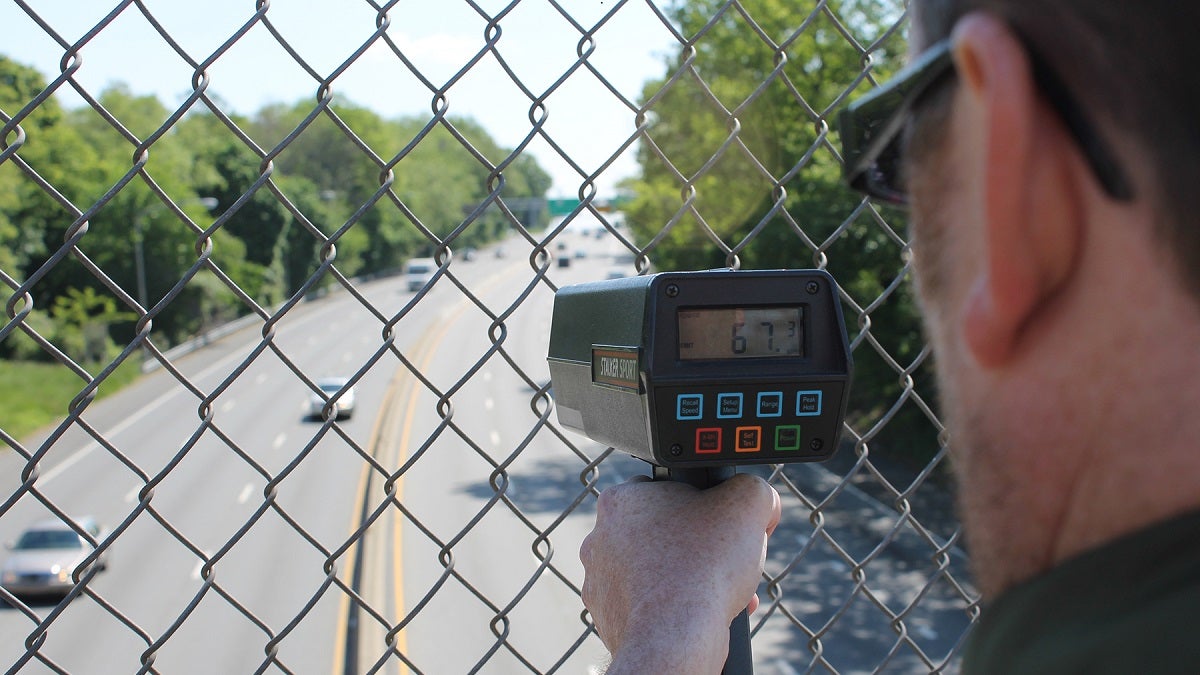Radar gun finds dangerous driving near Philly-area schools (and speeders anywhere cars go)

During NewsWorks' tour of Northwest Philadelphia and beyond, we stopped off at a Route 1 overpass on the cusp of Germantown and East Falls. (Matthew Grady/for NewsWorks)
The Malvern School and its day camp sit along Creek Road in Thornbury Twp., Delaware County.
The school educates about 150 students between the ages of 6 months and 8 years old. The camp hosts about three times as many youths between kindergarten-age and their early teens. Creek Road is a windy, tree-lined two-lane shortcut for many motorists heading to and from Route 1. And, Thornbury Twp. does not have its own police force.
A call for help
When NewsWorks asked readers to recommend locations to monitor speeders with a radar gun, we received several suggestions to focus on school zones for this second effort.
None pleaded as strongly as Eric Friedman, a parent whose child attended the school through last August.
“During pickup and drop-off times, when this lot is full of children — mostly babies and toddlers — it is usual to see cars exceeding the 15 mph posted limit by 40 or 50 miles per hour just feet from the kids,” he said. “The situation is so bad in this particular school zone that it is a hazardous maneuver, risking a collision from behind, to drive at anything close to the 15 mph limit.”
Requests for the State Police to monitor the situation have not resulted in any presence at the site, so we made sure to check it out for ourselves. Boy, was Friedman right.
An outlier of a site
Among the 28 locations at which NewsWorks radared the speed of some 1,150 vehicles during the week of May 13, the Malvern School zone featured the highest number of vehicles driving more than double the posted speed limit.
Of the 75 cars which zipped by on a rainy Thursday morning, with the school zone signs still flashing, 71 of them were driving more than double. Four vehicles actually more than tripled it. A Mazda 3 hatchback led the charge clocking in at 56 mph.
“Any incident at this location,” Freidman said, “is likely to result in injury to or death of a child whose right to enter and exit their parent’s car safely must surely be superior to the right to drive at any speed you like along Creek Road.”
When Malvern School CFO learned what we were doing, she was ecstatic that someone was finally paying attention to their worrisome issue.
She said trucks going to and from a nearby quarry, and commuters gliding along their Route 1 shortcut, make for a dangerous situation, albeit one that has not resulted in a student getting fatally struck.
Still, it’s a constant worry, as students sometimes have to walk from buses on the roadway, and from homes in the immediate area across Creek Road.
“It took us two years to even get those [school-zone warning] signs put up to help reduce speeds,” Rhen told NewsWorks. “It took a parent complaining to the township for them to post the [flashing school-zone] sign, and then to put us in touch with the State Police. They said, ‘We’ve put it on the docket.'”
And how did that work out?
“They’ve not once been here,” Rhen said.
Cpl. Gerald McShea, media contact for the State Police barracks which covers that area, said Thursday afternoon that he would look into whether any plans are in the works to send a trooper to the area based on community concerns.
“When it comes to schools, when someone contacts the barracks, a trooper who’s available will sit out in the area and issue tickets,” said McShea, who was reaching out to their patrol division in Media. “We’ll make an effort to get someone out there. Usually, that has an effect.”
Big-picture observations
The worries at Malvern School seemingly held true at least at the 28 spots NewsWorks visited throughout the region.
Here are a few noticeable traffic occurrences:
We saw a Suzuki motorcycle going 80 miles per hour on Martin Luther King Boulevard around 4 p.m. one Monday.
We watched a Chevy Tahoe, with a logo marking it as a Homeland Security vehicle, hit 47 mph while leaving the Wissahickon Charter School’s 15-mph zone the next morning.
We listened as a passerby warned us not to step into the street at Bryn Mawr and Lancaster avenues, the site of a recent hit-and-run of a mother and her 5-year-old twins, because while cars aren’t hitting high speeds, being a pedestrian there is still like playing Frogger amid distracted drivers.
We heard motorists yell some not-so-nice things out of their car windows when they saw our radar gun pointed at them.
We saw speeders weaving through pedestrian traffic outside SugarHouse Casino, where the finishing touches would be put on a crosswalk in the weeks afterwards, after a woman fought for it with regularity.
(Said Emily Soloby, who would ride her bicycle daily from her South Philly home to she and her husband’s AAA School of Trucking in Fishtown, “I’m just thrilled they are doing something. It took a while to get a response, but that’s typical … when you are dealing with agencies.” SugarHouse spokeswoman Leigh Whitaker, who said “there always seems to be a near-something happening there” was pleased that the project hinging on SEPTA, PECO and the Water and Streets Departments is finally complete.)
Specifically schools
We tabulated an average speed of 28 miles per hour at William Penn Charter School’s flashing school-zone sign, and marked down 17 of 40 vehicles which more than doubled the speed limit outside Pastorius Elementary in East Germantown where, just last year, a young girl was struck by a car.
Schools were, in fact, a problem area, as 131 of the 215 vehicles we saw doubling the speed limit (and all six which tripled it) did so in 11 school zones all across the city and suburbs.
However, when Larry Abney, crossing guard at Thomas Mifflin School in East Falls, was told that the highest speed recorded one morning was in the low 40s, he said, “Come back. You’ll see people blazing through here.”
By using the interactive map at the bottom of this story, you can see specific numbers, locations and top and average speeds at every site NewsWorks visited. Schools are represented by a school-house icon to help you see those specifically.
Traditional hotspots live up to reputations
If Trivial Pursuit had a “speeding-in-Philly” question, and Lincoln, Kelly and MLK Drives were listed as mainstay answers, the correct move would be saying “all of the above.”
Lincoln and Kelly drivers were the highlight of our September radar feature. By pure numbers, they led the charge again in May’s. (Remember: School zones are 15 mph, so you won’t see the higher-level speeders there.)
Of 335 cars radared on that trio of roadways leading to Northwest Philadelphia, 53 more than doubled the respective speed limits. (Henry Avenue can also be thrown into that mix; while there were no vehicles doubling the speed limit, there was an SUV which hit 63 mph outside W.B. Saul High School in Roxborough.)
Local crackdown
While Creek Road worries rued the lack of State Police response, Philadelphia Police Traffic Division Sgt. William Stermel lauded their highway troopers for helping out with their ongoing speeding crackdown on Kelly, Lincoln and MLK Drives.
Since early April, city and state police from the same barracks which covers the area near the Malvern School have teams up on six radar details.
According to statistics from the first five details, more than 190 motorists have been stopped for speeding on those three roadways. (During the NewsWorks stop on MLK Drive, we saw one cruiser in pursuit of a BMW that passed us as a shade under 70 mph.)
Stermel said that since his lieutenant reached out to request their assistance — by law, State Police are the only law-enforcement entity permitted to use radar — cooperation between the agencies has been optimal and that “people have been slowing down” since there are few places to hide marked units along those roadways.
“Ninety-nine percent of the people tell us they knew they were speeding. When the one percent says we’re lying, we point to the back of the ticket and tell them they can tell it to the court,” Stermel told NewsWorks. “People who knew we were there were still flying by us.”
Logistically, a State Police trooper sits in one location and communicates a vehicle’s description and speed to a city officer who then pulls the driver over. Stermel said this effort is in its infant stage, meaning that there are plans to continue it into the future.
While portions of Lincoln Drive are not pedestrian-focused, police have a legitimate concern for the joggers, walkers and bicyclists along heavily traveled Kelly Drive.
“With the nice weather, knowing everybody would be back out there, the joggers, the bicyclists, we’re trying to make it a little safer for them, and for people coming in and out of the city,” Stermel said. Some drivers “could care less about pedestrians and bicyclists, but we just don’t need anybody getting killed out there. As long as our manpower lets us, we’re going to continue to do this.”
When NewsWorks shared its numbers with Stermel, the peak speeds along Kelly, Lincoln and MLK Drives surprised him, as their tickets topped out around 70 miles per hour.
As for the school-zone findings, he said he would look at our numbers and discuss setting up this exact kind of radar detail at our school locations when students return to school in September.
No reason not to speed?
Which brings us back to the Malvern School.
Having waited for State Police backup for a while now, Rhen and Friedman both said they hope this story will help draw attention to what they deem a tragedy waiting to happen.
Putting it into concrete context, for Creek Road and well beyond, was Rhen, who said she was not surprised by the numbers that NewsWorks found on the roadway outside.
“If you can get away with it,” she said, “of course you’ll speed.”
(Traffic map created by NewsWorks Community Editor Neema Roshania)
WHYY is your source for fact-based, in-depth journalism and information. As a nonprofit organization, we rely on financial support from readers like you. Please give today.




